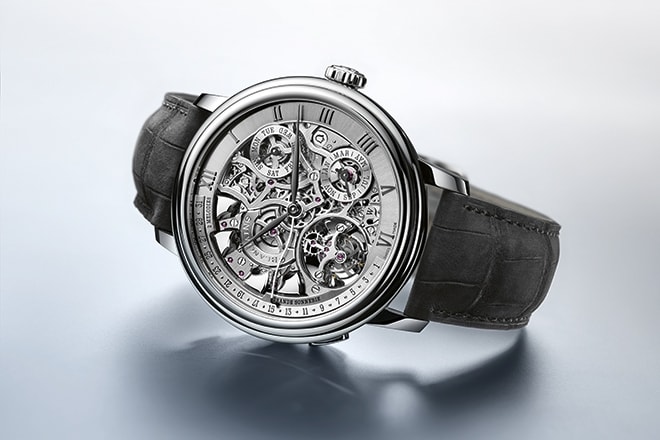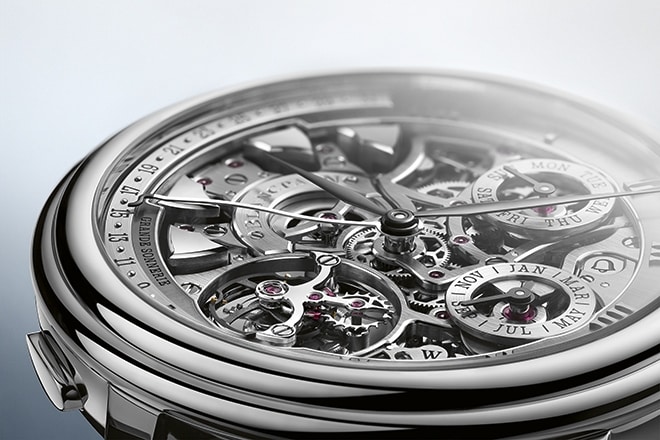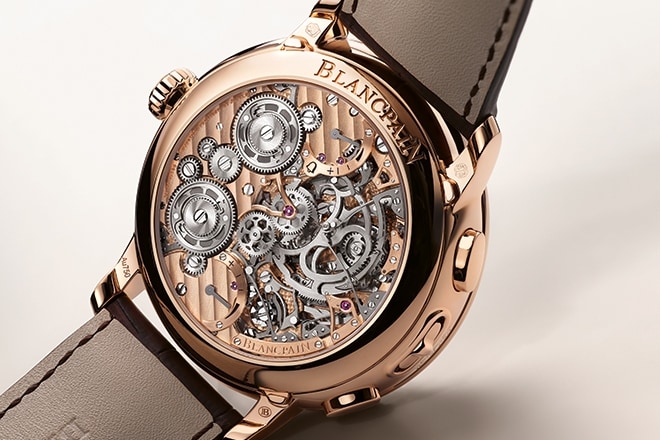Blancpain Grande Double Sonnerie
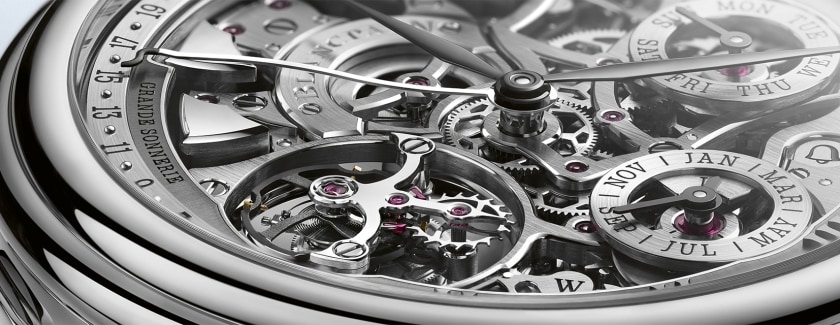
Blancpain’s Grande Double Sonnerie Opens a New Frontier in the World of Grand Complications
Seemingly impossible when the idea was spawned, the Grande Double Sonnerie has become a reality and a watchmaking first. This new Blancpain two melody grande sonnerie, petite sonnerie and minute repeater has been combined with a flying tourbillon and retrograde perpetual calendar, truly breaking new ground in the world of grand complications.
- World premiere: wristwatch grande sonnerie with two selectable melodies, chosen via a pusher on the case — the classic four-note Westminster chime and an original Blancpain melody composed by musician Eric Singer. Ultra-exclusive among wristwatch grande sonneries, it plays all four quarters on the hour, offering an extended performance.
- Retrograde perpetual calendar: entirely reimagined with a new construction, fully integrated into the movement, and equipped with Blancpain’s patented under-lug correctors, redesigned to allow easy fingertip adjustment without tools.
- Flying tourbillon: Blancpain’s emblematic flying tourbillon — the world’s first, unveiled in 1989 — updated with a silicon balance spring and a 4 Hz frequency.
- The most complicated watch in Blancpain’s history: an eight-year project encompassing 1,200 technical drawings, 21 patents developed during development (13 integrated into the final construction of the movement), 1,053 components for the movement, out of a total of 1,116 components, all entirely designed, produced, assembled, and decorated in-house.
- Exceptional sound: Four notes (E, G, F, B) produced by four distinct hammers. An acoustic membrane integrated into the bezel enhances sound transmission, ensuring remarkable musical quality well beyond mere volume. Silent magnetic regulator.
- Traditional artisanal finishing: 26 bridges and mainplate crafted in 18 ct gold. Traditional hand-finishing including anglage (135 inward angles), perlage, mirror polishing, diamond milling, and straight graining, all executed by hand in Blancpain’s finishing workshop in Le Brassus. Components are decorated on both visible and hidden surfaces.
- Safety mechanisms: five safety systems integrated into the movement to prevent damage from incorrect handling.
- A watch designed to be worn: despite the extreme complexity of the movement, the watch — which has passed all tests and certifications — remains highly wearable, with a diameter of 47 mm, a lug-to-lug of 54.6 mm, and a thickness of 14.5 mm.
- Special presentation box: crafted from wood sourced from the legendary Risoud forest in the Vallée de Joux, the case is more than a presentation box — it perpetuates the centuries-old tradition of resonance spruces, prized by luthiers for their exceptional acoustic qualities. In this spirit, it acts as a natural soundboard, amplifying the chime and linking the timepiece to the cultural and artisanal heritage of the valley.
- Ultimate personalization: each piece can be custom-made according to the wishes of its owner, ensuring absolute exclusivity.
Blancpain’s Heritage
From its roots as a family enterprise, which for two centuries remained within the Blancpain family, the house prides itself on its faithfulness to grand watchmaking traditions. From its workshops located in the Vallée de Joux, the cradle of fine watchmaking, 100% of its movements are made in house, from production to design, assembling, and finishing. All of watchmaking’s emblematic complications and constructions are represented in Blancpain’s collections: complete calendar moon phase, perpetual calendars, annual calendars, tourbillons, carrousels, chronographs, GMTs, reveils, minute repeaters and now the grande sonnerie. As well Blancpain produces its own steel, ceramic, gold, platinum and titanium cases.
Grand complications feature prominently in the history of Blancpain, most notably the 1735. The most complicated automatic winding wristwatch of its era, the 1735 featured a minute repeater, split second chronograph, perpetual calendar and tourbillon.
The Sounding of Time
Today we think of the chiming of time as a complication, an embellishment of the regular running train of a watch, signaling that the timepiece is among the rarest, most enchanting, and most impressive of all horological creations. However, beginning in the 14th century things were the opposite. The sounding of time with large monastery and village clocks became fundamental, exceeding in importance the display of time with hands and dial. The organization and regulation of the patterns of life for all of those living and working within earshot depended upon the sounding of time. It is that heritage of sounding the time in passage that lies behind grande sonneries. The Westminster, one of the two melodies of the Blancpain Grande Double Sonnerie, dates to 1793 to Cambridge’s Church of St. Mary’s the Great. Its adoption for London’s Big Ben led to the name by which it is known today.
Grande Sonnerie & Petite Sonnerie
Until 1992, there were no wristwatch grande sonneries. Chiming of time was confined to minute repeaters which sound on demand. Most often initiated by the pulling of slide, which arms the sonnerie, with rare exceptions, minute repeaters would sound the time through a combination of two notes, one high, one low.
Grande and petite sonneries, by contrast, sound the time in passage. The horological definition of grande sonnerie is one that sounds on the hour, and at each quarter hour, sounds both the hour and the quarter. In general, there are two varieties of petite sonneries; the most simple sounds on the hour and does not sound the quarters. The more complicated variety sounds on the hour and sounds the quarters without repeating the hour. Both grande and petite sonneries are powered by a barrel in the movement and do not require arming by pulling of a slide or other arming action by the owner. For Blancpain’s Grande Double Sonnerie, the movement is fitted with two separate barrels, one powers the regular running train of the timepiece, the second powers the grande sonnerie, petite sonnerie, and, so as to dispense with the necessity of arming with a slide, the minute repeater as well.
Sounding of Time with a Melody
The first wristwatch grande sonnerie sounded time following the two tone formula utilized by almost all minute repeaters: the hour with a low note, the minutes with a high note and the quarters with a combination of the two. With few exceptions, this formula has been followed by other grande sonneries in the market.
Blancpain’s horizons are far broader with its Grande Double Sonnerie. Marc A. Hayek’s vision saw the possibility for a genuine melody. The challenges were enormous. To compose a melody, there would be four notes: Mi, Sol, Fa, Si. In and of itself, this brings a doubling of the complexity of the movement as four different hammers, one for each note, are called for. That, however, is only the first step to take sounding into the domain of melody. With the much simpler two tone sounding, there is great flexibility in the frequencies of the notes, both taken individually and in relation to each other. For a melody there is no such flexibility as the pitch of each note must be perfect so that the notes can be played together. In many ways the analogy of a concert master is apt. Before a recital begins, generally an oboe sounds the note “A” following which the concert master tunes the orchestra so that the notes of all instruments are playing in the exact same key and pitch. Using a laser which can measure the frequency of vibrations, Blancpain’s watchmakers test and adjust Grande Double Sonnerie’s sounding gongs so that the frequency of each of the four notes is perfectly in tune.
There is a second imperative in the playing of a melody, distinct from the simple two-tone sounding of time: perfect tempo. The human ear can detect irregularities as fine as a tenth of a second when listening to a melody. Like a minute repeater, the Grande Double Sonnerie is equipped with a regulator to govern the pace of the chiming. In this case, Blancpain has fitted the sonnerie with a patented magnetic regulator – a major advance over earlier designs. It is completely silent, adding no mechanical noise to compete with the chiming, and ensures greater stability of tempo than traditional constructions.
Yet for a melody, even greater precision is required. Just as with the four tones, the intervals between each note are scientifically measured. In Blancpain’s own laboratories, our engineers provide the analytical data and technical insights that guide the master watchmakers. With their traditional savoir-faire, they then make microscopic adjustments – on the order of a micron – to the shape of the teeth in the sonnerie mechanism. This collaboration between advanced technology and artisanal craftsmanship ensures a perfectly regular tempo, held within a tolerance of a tenth of a second.
Blancpain’s savoir-faire in creating the melodies is on full display on the hour. In contrast with other grande sonneries, which on the hour sound only the hours but no quarters, the Blancpain Grande Double Sonnerie offers the owner the exquisitely long playing of the hours followed by sounding of four full quarters, that is to say the melody in full.
Eric Singer
A passionate watch collector and famed musician, Eric Singer is an American drummer best known for his long-standing association with the hard rock band KISS. Throughout his career, he has also collaborated with Black Sabbath, Alice Cooper, Lita Ford, Badlands, Brian May, Gary Moore, and his own band ESP. Having appeared on more than 75 albums and 11 EPs, Singer has earned a reputation as one of the most versatile and respected drummers in the world of rock music.
A close friend of Marc A. Hayek, Singer was the natural choice when Hayek decided to open a new frontier in watchmaking by equipping the Grande Double Sonnerie with a second melody. Singer composed an original piece specifically for the project, a completely new creative experience for him. In developing the composition, Singer collaborated closely with his friend and acclaimed keyboardist Derek Sherinian, whose musical insight and harmonic sense were integral to shaping the final melody. Together, they transformed the technical limitations of the movement into a unique musical signature for the timepiece.
Singer’s melody is labeled “Blancpain”. With the push of a button, the owner may select between either the Westminster or the Blancpain melody as the mood strikes. A smooth feel of the selection button that switches back and forth between the two is ensured as the mechanism is equipped with a column wheel.
The Tourbillon
Since its introduction in 1989, Blancpain’s flying tourbillon has become emblematic of the house. The term “flying” is used as, unlike most constructions which suspend the tourbillon between a lower and upper bridge, this design removes the upper bridge, supporting the carriage and its components of the balance wheel, spiral and escapement entirely from below. Revolutionary when it debuted, Blancpain’s flying construction was a wristwatch world first and prized as it offered an unobstructed view of the tourbillon’s festival of motion.
The Grande Double Sonnerie elevates this icon further. Its frequency has been increased from 3 Hz to 4 Hz, and its balance spiral is crafted in silicon, ensuring resistance to magnetism along with three attributes that enhance chronometric performance: lighter weight, ideal geometry, and more constant amplitude as the mainspring force changes. Beyond its technical advances, the Grande Double Sonnerie also celebrates the aesthetic beauty of the tourbillon: the finishing of its cage — especially the mirror-polished surfaces — creates an extraordinary play of light, magnifying the grace of the mechanism and drawing the eye to its every movement.
The Retrograde Perpetual Calendar
A timepiece of the breed of the Grande Double Sonnerie merits the inclusion of perpetual calendar, one of watchmaking’s most prestigious and useful complications. Although Blancpain’s collections offer several varieties of perpetual calendars, the creation of the Grande Double Sonnerie called for an entirely new construction, one which is seldom, if ever, seen in the world of grand complications. The norm for inclusion of this functionality in grand complications seen elsewhere, is to implement the calendar mechanism as a module on a dedicated plate separate from the mainplate of the movement. That approach, however, would have been inconsistent with the open architecture of the Grande Double Sonnerie as a dedicated calendar plate would of necessity cover and block the view of the sonnerie. Instead, Blancpain undertook the much more difficult approach of fully integrating the calendar into the movement, avoiding the standard approach of a separate plate.
The date indication is positioned along the left perimeter of the movement, while the day of the week, month, and leap year are displayed on two dedicated subdials on the right side. Normally, Blancpain’s patented under-lug correctors are integrated into the case, with small springs ensuring their return. This allows for easy adjustments with just a fingertip, without the need for any tool. For the Grande Double Sonnerie, however, the presence of the membrane required the system to be re-imagined: the correctors, along with their return springs, have this time been integrated directly into the movement — an unprecedented solution that combines ease of use with technical elegance, true to Blancpain’s spirit.
Finishing
Fine finishing is a form of art and Blancpain has a finishing workshop in Le Brassus dedicated to its high complications. Here the full range of traditional finishing motifs and techniques are practiced by skilled craftsmen.
To highlight the beauty of their handwork, Blancpain selected 18 ct. gold for the Grande Double Sonnerie mainplate and bridges, a material that not only offers a stunning visual effect but also demands exceptional skill and patience as its softness makes it far more delicate to work with than traditional metals, leaving no room for error and requiring absolute mastery from the artisans. Not only does gold bring a unique warmth to the appearance of the movement, its polished surfaces glow more brilliantly than with brass or German silver more commonly used.
As should be the case with every timepiece of breed, Blancpain lavishes its finishes not only on the sides of components that can be seen through the open dial or clear case back, but the sides otherwise hidden from view that would ordinarily only be viewed by the watchmaker assembling the piece or, years from now, by a watchmaker doing a service.
Testament to the elaborate hand finishing practiced in the workshop are the 135 crisp interior angles brought to movement components. These bright angle finishes can only be created through painstaking handwork beginning with hand carving of the edges, followed by wood polishing with successively finer abrasives and, the final touch, polishing with the stems of gentian wood that grows wild in the Vallée de Joux.
Savvy observers, knowing that sharp interior angles cannot be produced using electric tools, carefully examine movement finishes for evidence of the angles as they are the sign of the finest hand applied traditional haute horlogerie finishing.
Related news
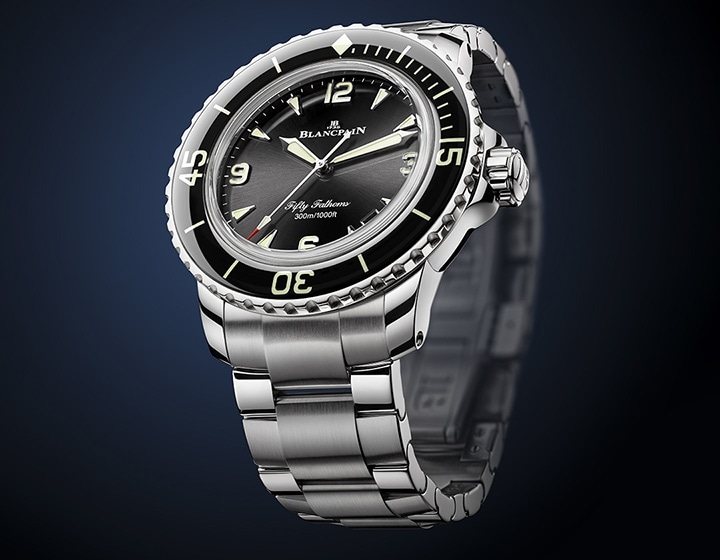
Blancpain Fifty Fathoms
Born from an icon that has shaped the history of watchmaking, the Fifty Fathoms Automatique 42mm in stainless steel joins Blancpain's permanent collection. Following the success of the 2023 limited edition, the Fifty Fathoms 70th Anniversary Act 1, and the brushed grade 23 titanium and red gold versions launched last year, this new model pays…

Blancpain Bathyscaphe Quantième Complet Phases de Lune
Blancpain is delighted to present the new Bathyscaphe Quantième Complet Phases de Lune, now fitted with an elaborately designed and patented black ceramic bracelet and a case made from the same material. With an assertive, sporty yet supremely elegant style, this model features a dial in vibrant shades of sunray-brushed blue. Available with a…

Swatch Ocean of Storms
A new ocean is joining the five watches and five oceans in the Blancpain X Swatch collaboration. Even though planet Earth only has five, Swatch is welcoming OCEAN OF STORMS into its Bioceramic Scuba Fifty Fathoms Collection that celebrates Blancpain’s iconic Fifty Fathoms, a watch that revolutionized watchmaking by becoming the first true diver’s…

